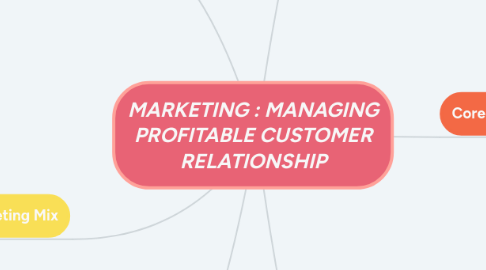
1. Marketing Process
1.1. 1. Understand the marketplace and customer needs and wants
1.2. 2. Design a customer value-driven marketing strategy
1.3. 3. Construct an integrated marketing program that delivers superior value
1.4. 4. Build profitable relationships and create customer delight
1.5. 5. Capture value from customers to create profit and customer equity
2. Core Concepts
2.1. 1. Need
2.1.1. State of felt deprivation
2.1.2. Example: need food, cloth
2.2. 2. Wants
2.2.1. Form of needs as shaped by culture and the individual
2.2.2. Example: wants Tealive
2.3. 3. Demands
2.3.1. Given their wants & resources, people demand product with benefits that add up to the most value and satisfaction
2.3.2. Example: Burger King vs Ramly Burger
2.4. 4. Marketing Offers
2.4.1. Combination of products, services, information or experiences that satisfy a need or want
2.5. 5. Value and Satisfication
2.5.1. - Marketers must deliver value to consumers - Customers form expectations about the value of various marketing offers
2.5.2. - A satisfied customer will buy again and tell others about their good experience, dissatisfied customer will tell about she/he experiences to other person
2.6. 6. Exchange, transaction and relationship
2.6.1. Exchange is the act of obtaining a desired object from someone by offering something in return
2.6.2. Transactions consists of a trade of values between two parties
2.6.3. Relationships are built through delivering value and satisfaction
2.7. 7. Marketing
2.7.1. Set of actual and potential buyers of a product
3. Marketing Management Orientations
3.1. Production Concept
3.1.1. Consumer : will favor products that available and highly affordable
3.1.2. Management : focus on improving production/distribution efficiency, should look for ways to increase production
3.2. Product Concept
3.2.1. Consumer : will favor products that offer most quality, performance and innovative features
3.2.2. Marketing Strategies : making continuous product improvements
3.3. Selling Concept
3.3.1. Consumer : will not buy enough of firm's product unless undertakes large-scale selling or more promotion effort
3.3.2. Marketing Strategies : aim to sell what they make rather than the market wants, if the company faces overcapacity
3.4. Marketing Concept
3.4.1. Company Goal : knowing the needs/wants of target market and delivering the desired satisfication better than competitor's do
3.5. The Societal-Marketing Concept
3.5.1. See the conflicts between consumer short run wants and consumer long run welfare
4. 4P Marketing Mix
4.1. 1. Product
4.1.1. Goods and services company offers to the target market
4.2. 2. Price
4.2.1. Amount of money customers have to pay to obtain the product
4.3. 3. Place
4.3.1. Company activities that make the product available to target consumers
4.4. 4. Promotion
4.4.1. Activities that communicate the merits of the product and persuade target customers to buy it
5. Managing Customer Relationships and Capturing Customer Value
5.1. Customer-Engangement Marketing
5.1.1. Fosters direct and continuous customer involvement in shaping brand conversations, experiences, and community
5.2. Consumer Generated Marketing
5.2.1. Brand exchanges created by consumers themselves.
5.3. Partner Relationship Management
5.3.1. Involves working closely with partners in other company departments and outside the company to jointly bring greater value to customers
5.4. Customer Lifetime Value
5.4.1. Value of the entire stream of purchases that the customer would make over a lifetime of patronage.
5.5. Customer Equity
5.5.1. Total combined customer lifetime values of all of the company’s customers
6. Marketing Challanges
6.1. Digital Age
6.1.1. Growth of the internet
6.1.2. 24/7 Marketing through internet
6.2. Globalization
6.2.1. Greater market coverage
6.2.2. More options for purchasing and manufacturing
6.3. Ethics and Social Responsibility
6.3.1. Marketers need to take great responsibility for the impact of their actions
6.4. Not-for-Profit-Marketing
6.4.1. Example : Performing arts (museum, orchestras)
6.5. Marketing Relationships
6.5.1. Target profitable customer
6.5.2. Keep profitable customer

